Numerical Simulation for the Combustion Chamber of a Reference Calorimeter
Abstract
:1. Introduction
- The burner provides and mixes the oxidant and the fuel, in addition to generating the flame. The combustion chamber and the heat exchanger are responsible for maximizing the heat transfer of combustion waste gases to its surroundings, usually water.
- The calorimeter vessel contains some fluid, usually water. Its function is to receive and measure the energy generated by the flame and waste gases of combustion, as well as maintain a homogeneous temperature within the contained fluid. The burner, the combustion chamber, and the heat exchanger are immersed in the calorimeter vessel.
- The jacket is another container that includes the calorimeter container and has a uniform, or at least known, temperature.
2. Numerical Methods and Procedures
- A 3-step mechanism contained by default in the software involving six species.
2.1. CFD Simulation Set Up
2.2. Computational Domain and Mesh
2.3. Boundary Conditions
3. Results
3.1. Comparison of Values at the Burner Exit
3.2. Selecting the Burner for the Reference Calorimeter
4. Discussion
5. Conclusions
Author Contributions
Funding
Conflicts of Interest
Abbreviations
| Two dimension | |
| B-40 | Burner of 40 millimeter height |
| B-60 | Burner of 60 millimeter height |
| B-65 | Burner of 65 millimeter height |
| B-70 | Burner of 70 millimeter height |
| B-75 | Burner of 75 millimeter height |
| B-80 | Burner of 80 millimeter height |
| B-90 | Burner of 90 millimeter height |
| B-100 | Burner of 100 millimeter height |
| H | Monoatomic hydrogen |
| C | Celsius degrees |
| CENAM | Centro Nacional de Metrologia |
| D | Diffusion coefficient |
| c | Concentration of chemical species |
| O | Monoatomic oxygen |
| O | Diatomic oxygen |
| OH | Phenol |
| HO | Water |
| HO | Hydrogen dioxide |
| CO | Carbon monoxide |
| CO | Carbon dioxide |
| HCO | Aldehyde |
| CHO | Formaldehyde |
| CH | Radical free methyl |
| CHO | Methoxide |
| CH | Methane |
| S | Source term |
| s | second |
| kg | kilogram |
| RNG | Re-normalization of the Group |
| EDC | Eddy Dissipation Concept |
| CFD | Computational Fluid Dynamics |
| ANSYS ICEM | extension of the meshing capabilities in ANSYS Meshing |
| DSC | Differential scanning calorimetry |
| m | Meter |
| m/s | meter per second |
| mm | millimeter |
| K | Kelvin degrees |
| NOx | Nitrous oxides |
| CV | Calorific value |
| P | Pressure |
| Probability Density Function | |
| PISO | Pressure-implicit with splitting of operators |
| SKEL | Skeletal |
| T | Temperature |
| Pa | Pascal |
| Density | |
| U | Velocity |
| u | Internal energy |
| Chemical specie i of reaction | |
| Y | Species concentrations |
| Viscosity | |
| Heat capacity | |
| Minimum velocity | |
| Maximum velocity | |
| Outlet temperature | |
| k | Thermal conductivity |
| Diffusion coefficient for the ith species |
References
- Yang, B.; Pope, S. An investigation of the accuracy of manifold methods and splitting schemes in the computational implementation of combustion chemistry. Combust. Flame 1998, 112, 16–32. [Google Scholar] [CrossRef]
- Cabeza, L.F.; Mehling, H.; Hiebler, S.; Ziegler, F. Heat transfer enhancement in water when used as PCM in thermal energy storage. Appl. Therm. Eng. 2002, 22, 1141–1151. [Google Scholar] [CrossRef]
- Giraldo, L.; Rodriguez-Estupiñán, P.; Moreno-Piraján, J.C. Isosteric Heat: Comparative Study between Clausius–Clapeyron, CSK and Adsorption Calorimetry Methods. Processes 2019, 7, 203. [Google Scholar] [CrossRef] [Green Version]
- ISO/TC 193. ISO 15971-Natural Gas—Measurement of Properties—Calorific Value and Wobbe Index; International Standard: Geneva, Switzerland, 2008. [Google Scholar]
- Ulbig, P.; Hoburg, D. Determination of the calorific value of natural gas by different methods. Thermochim. Acta 2002, 382, 27–35. [Google Scholar] [CrossRef]
- ISO/TC 193. ISO 6976:2016-Natural Gas—Calculation of Calorific Values, Density, Relative Density and Wobbe Indices from Composition; International Standard: Geneva, Switzerland, 2016. [Google Scholar]
- Schley, P.; Beck, M.; Uhrig, M.; Sarge, S.; Rauch, J.; Haloua, F.; Filtz, J.R.; Hay, B.; Yakoubi, M.; Escande, J.; et al. Measurements of the calorific value of methane with the new GERG reference calorimeter. Int. J. Thermophys. 2010, 31, 665–679. [Google Scholar] [CrossRef]
- Rossini, F.D.; Jessup, R. Heat and free energy of formation of carbon dioxide, and of the transition between graphite and diamond. J. Res. Natl. Bur. Stand. USA 1938, 21, 491–513. [Google Scholar] [CrossRef]
- Haloua, F.; Hay, B.; Filtz, J. New French reference calorimeter for gas calorific value measurements. J. Therm. Anal. Calorim. 2009, 97, 673–678. [Google Scholar] [CrossRef]
- Elattar, H.F.; Specht, E.; Fouda, A.; Rubaiee, S.; Al-Zahrani, A.; Nada, S.A. Swirled Jet Flame Simulation and Flow Visualization Inside Rotary Kiln—CFD with PDF Approach. Processes 2020, 8, 159. [Google Scholar] [CrossRef] [Green Version]
- Xu, K.; Wang, G.; Wang, L.; Yun, F.; Sun, W.; Wang, X.; Chen, X. CFD-Based Study of Nozzle Section Geometry Effects on the Performance of an Annular Multi-Nozzle Jet Pump. Processes 2020, 8, 133. [Google Scholar] [CrossRef] [Green Version]
- Wang, H.; Xu, R.; Wang, K.; Bowman, C.T.; Hanson, R.K.; Davidson, D.F.; Brezinsky, K.; Egolfopoulos, F.N. A physics-based approach to modeling real-fuel combustion chemistry—I. Evidence from experiments, and thermodynamic, chemical kinetic and statistical considerations. Combust. Flame 2018, 193, 502–519. [Google Scholar] [CrossRef]
- Xu, R.; Wang, K.; Banerjee, S.; Shao, J.; Parise, T.; Zhu, Y.; Wang, S.; Movaghar, A.; Lee, D.J.; Zhao, R.; et al. A physics-based approach to modeling real-fuel combustion chemistry—II. Reaction kinetic models of jet and rocket fuels. Combust. Flame 2018, 193, 520–537. [Google Scholar] [CrossRef]
- Jia, Z.; Ye, Q.; Wang, H.; Li, H.; Shi, S. Numerical Simulation of a New Porous Medium Burner with Two Sections and Double Decks. Processes 2018, 6, 185. [Google Scholar] [CrossRef] [Green Version]
- Gran, I.R.; Magnussen, B.F. A numerical study of a bluff-body stabilized diffusion flame. Part 1. Influence of turbulence modeling and boundary conditions. Combust. Sci. Technol. 1996, 119, 171–190. [Google Scholar] [CrossRef]
- Ertesvåg, I.S.; Magnussen, B.F. The eddy dissipation turbulence energy cascade model. Combust. Sci. Technol. 2000, 159, 213–235. [Google Scholar] [CrossRef]
- Ashoke, D.; Oldenhof, E.; Sathiah, P.; Roekaerts, D. Numerical simulation of delft-jet-in-hot-coflow (djhc) flames using the eddy dissipation concept model for turbulence–chemistry interaction. Flow Turbul. Combust. 2011, 87, 537–567. [Google Scholar] [CrossRef] [Green Version]
- De Giorgi, M.G.; Sciolti, A.; Ficarella, A. Application and Comparison of Different Combustion Models of High Pressure LOX/CH4 Jet Flames. Energies 2014, 7, 477–497. [Google Scholar] [CrossRef] [Green Version]
- Dasgupta, D.; Sun, W.; Day, M.; Lieuwen, T. Effect of turbulence–chemistry interactions on chemical pathways for turbulent hydrogen–air premixed flames. Combust. Flame 2017, 176, 191–201. [Google Scholar] [CrossRef] [Green Version]
- Correa, S.M. Turbulence-chemistry interactions in the intermediate regime of premixed combustion. Combust. Flame 1993, 93, 41–60. [Google Scholar] [CrossRef]
- Tahir, F.; Ali, H.; Baloch, A.A.; Jamil, Y. Performance Analysis of Air and Oxy-Fuel Laminar Combustion in a Porous Plate Reactor. Energies 2019, 12, 1706. [Google Scholar] [CrossRef] [Green Version]
- Davidy, A. CFD Simulation of Forced Recirculating Fired Heated Reboilers. Processes 2020, 8, 145. [Google Scholar] [CrossRef] [Green Version]
- Avdic, A.; Kuenne, G.; di Mare, F.; Janicka, J. LES combustion modeling using the Eulerian stochastic field method coupled with tabulated chemistry. Combust. Flame 2017, 175, 201–219. [Google Scholar] [CrossRef]
- Droniou, J. Finite volume schemes for diffusion equations: Introduction to and review of modern methods. Math. Model. Methods Appl. Sci. 2014, 24, 1575–1619. [Google Scholar] [CrossRef]
- Smith, G.P.; Golden, D.M.; Frenklach, M.; Moriarty, N.W.; Eiteneer, B.; Goldenberg, M.; Bowman, C.T.; Hanson, R.K.; Song, S.; Gardiner, W., Jr.; et al. GRI-Mech 3.0, 1999. 2011. Available online: http://combustion.berkeley.edu/gri-mech/version30/text30.html (accessed on 11 May 2020).
- Fortunato, V.; Giraldo, A.; Rouabah, M.; Nacereddine, R.; Delanaye, M.; Parente, A. Experimental and Numerical Investigation of a MILD Combustion Chamber for Micro Gas Turbine Applications. Energies 2018, 11, 3363. [Google Scholar] [CrossRef] [Green Version]
- Bieleveld, T.; Frassoldati, A.; Cuoci, A.; Faravelli, T.; Ranzi, E.; Niemann, U.; Seshadri, K. Experimental and kinetic modeling study of combustion of gasoline, its surrogates and components in laminar non-premixed flows. Proc. Combust. Inst. 2009, 32, 493–500. [Google Scholar] [CrossRef]
- Bedjidian, M.; Belkadhi, K.; Boudry, V.; Combaret, C.; Decotigny, D.; Gil, E.C.; de La Taille, C.; Dellanegra, R.; Gapienko, V.; Grenier, G.; et al. Performance of Glass Resistive Plate Chambers for a high-granularity semi-digital calorimeter. J. Instrum. 2011, 6, P02001. [Google Scholar] [CrossRef] [Green Version]
- Minotti, A.; Sciubba, E. LES of a Meso Combustion Chamber with a Detailed Chemistry Model: Comparison between the Flamelet and EDC Models. Energies 2010, 3, 1943. [Google Scholar] [CrossRef] [Green Version]
- Farokhi, M.; Birouk, M. Application of Eddy dissipation concept for modeling biomass combustion, Part 1: Assessment of the model coefficients. Energy Fuels 2016, 30, 10789–10799. [Google Scholar] [CrossRef]

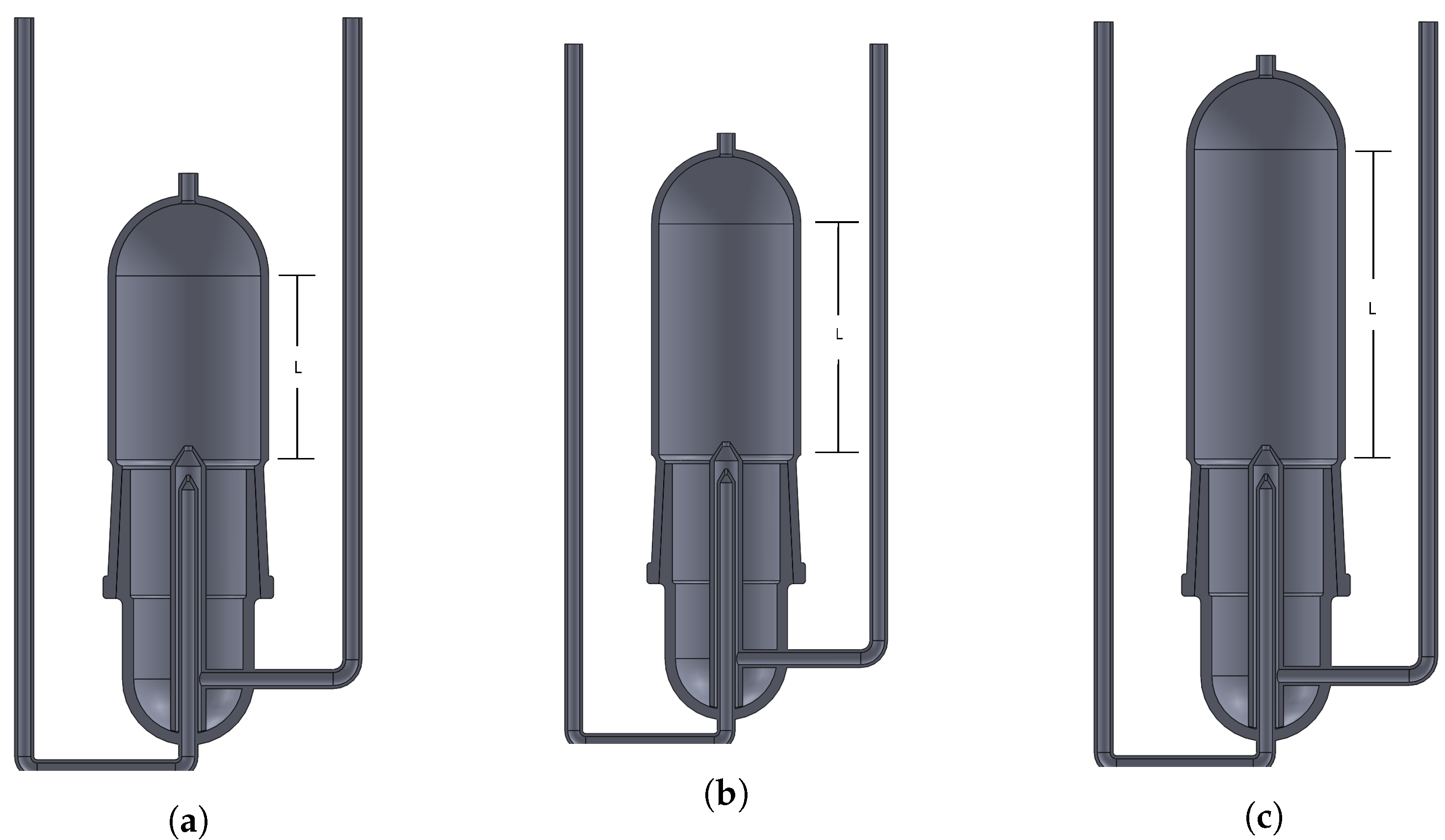
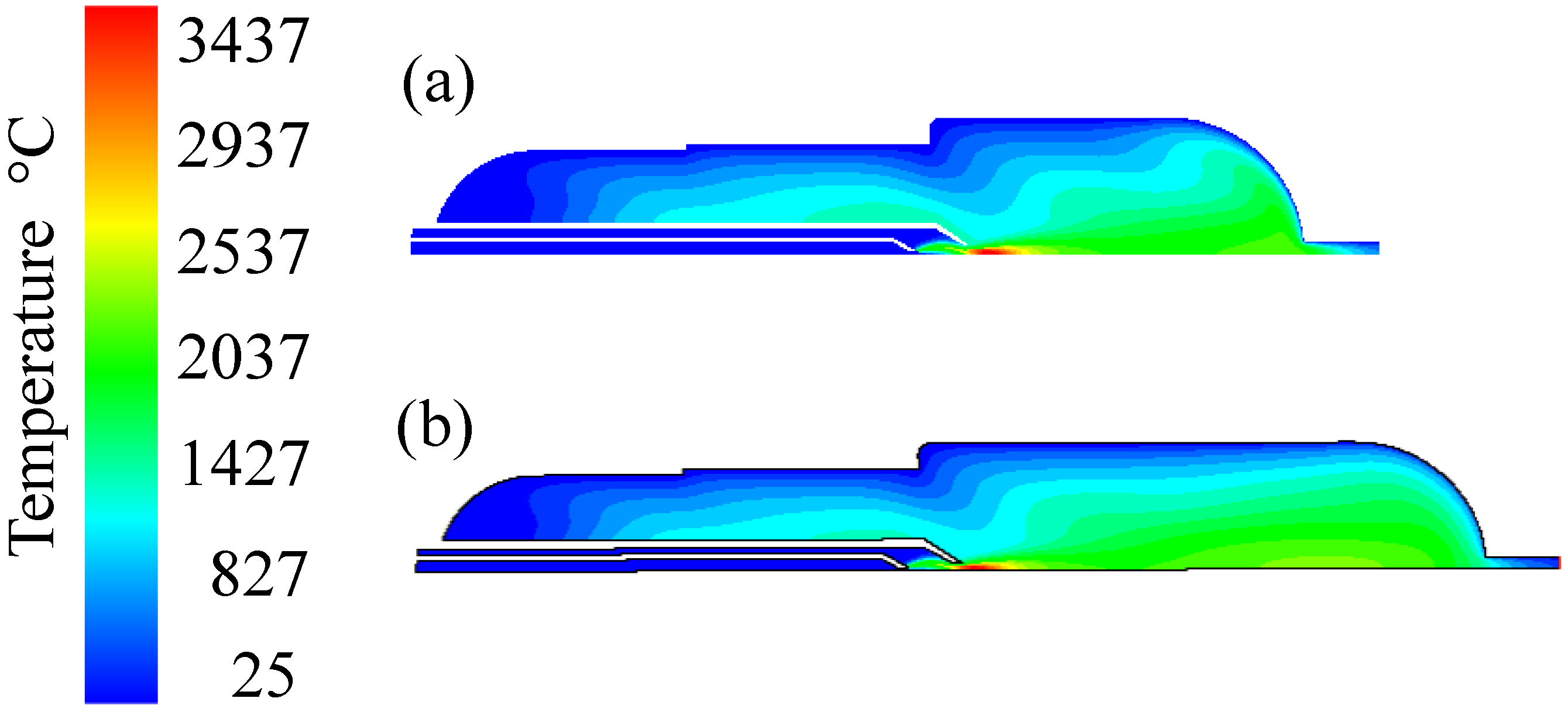

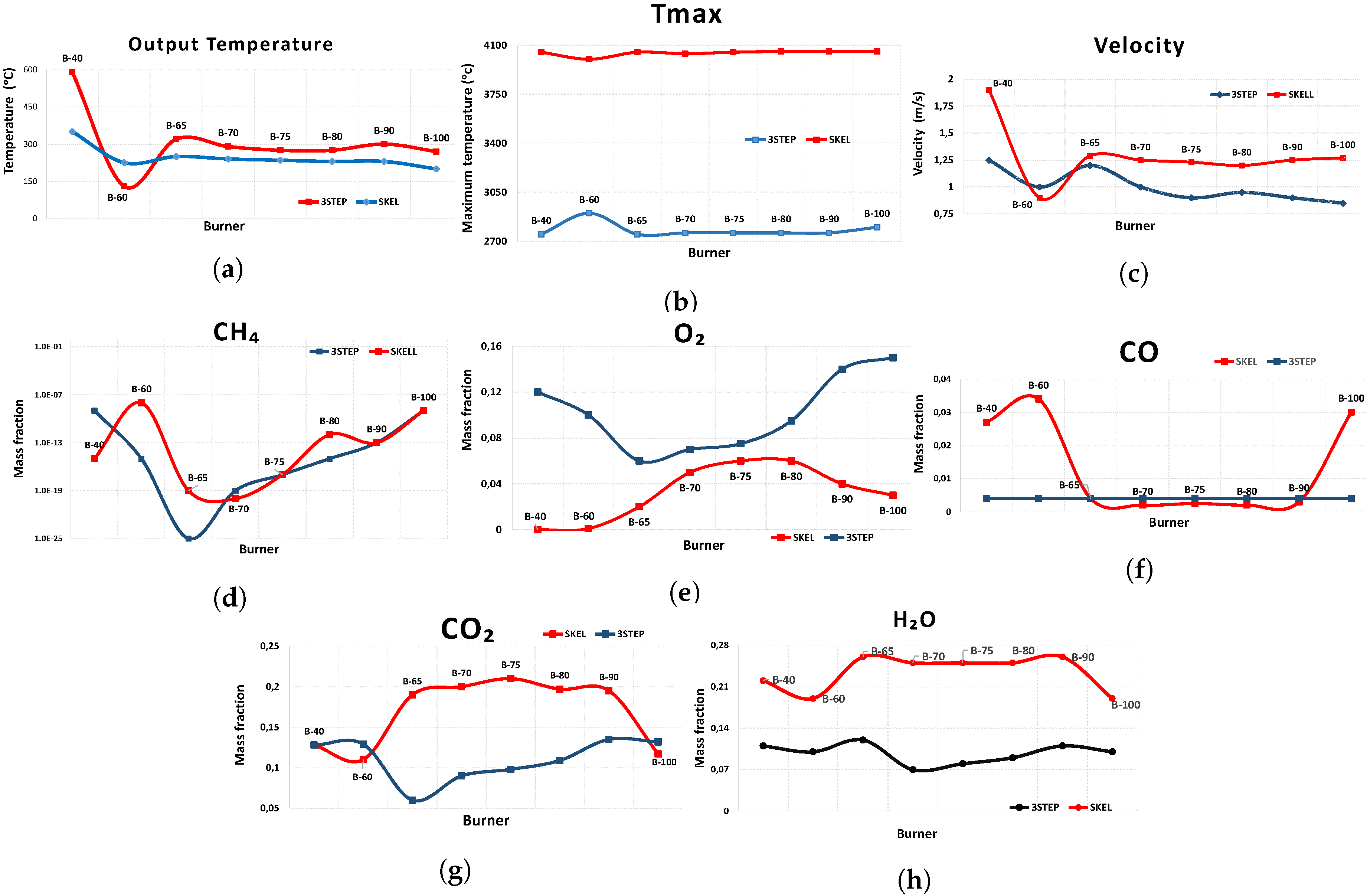
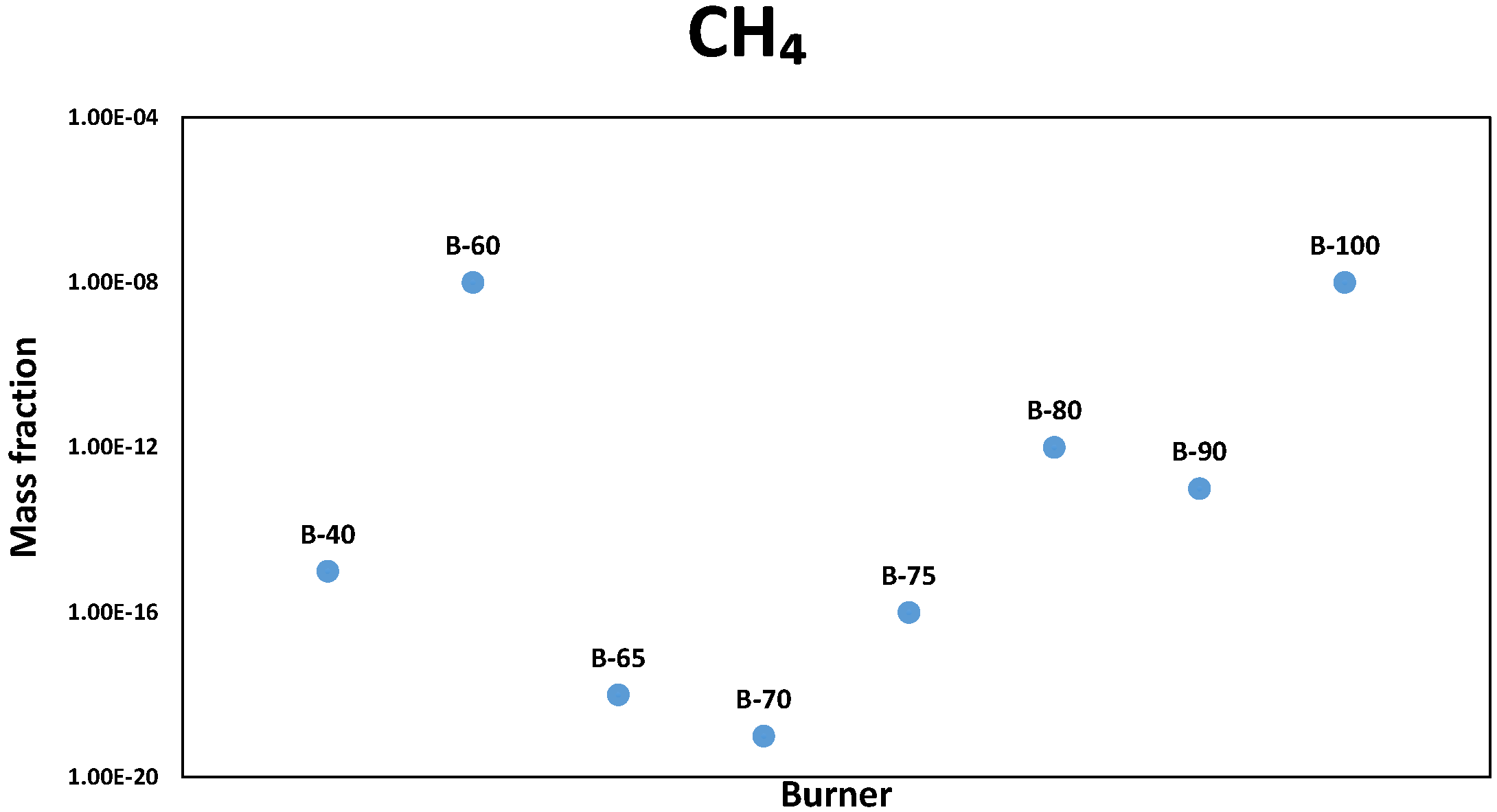
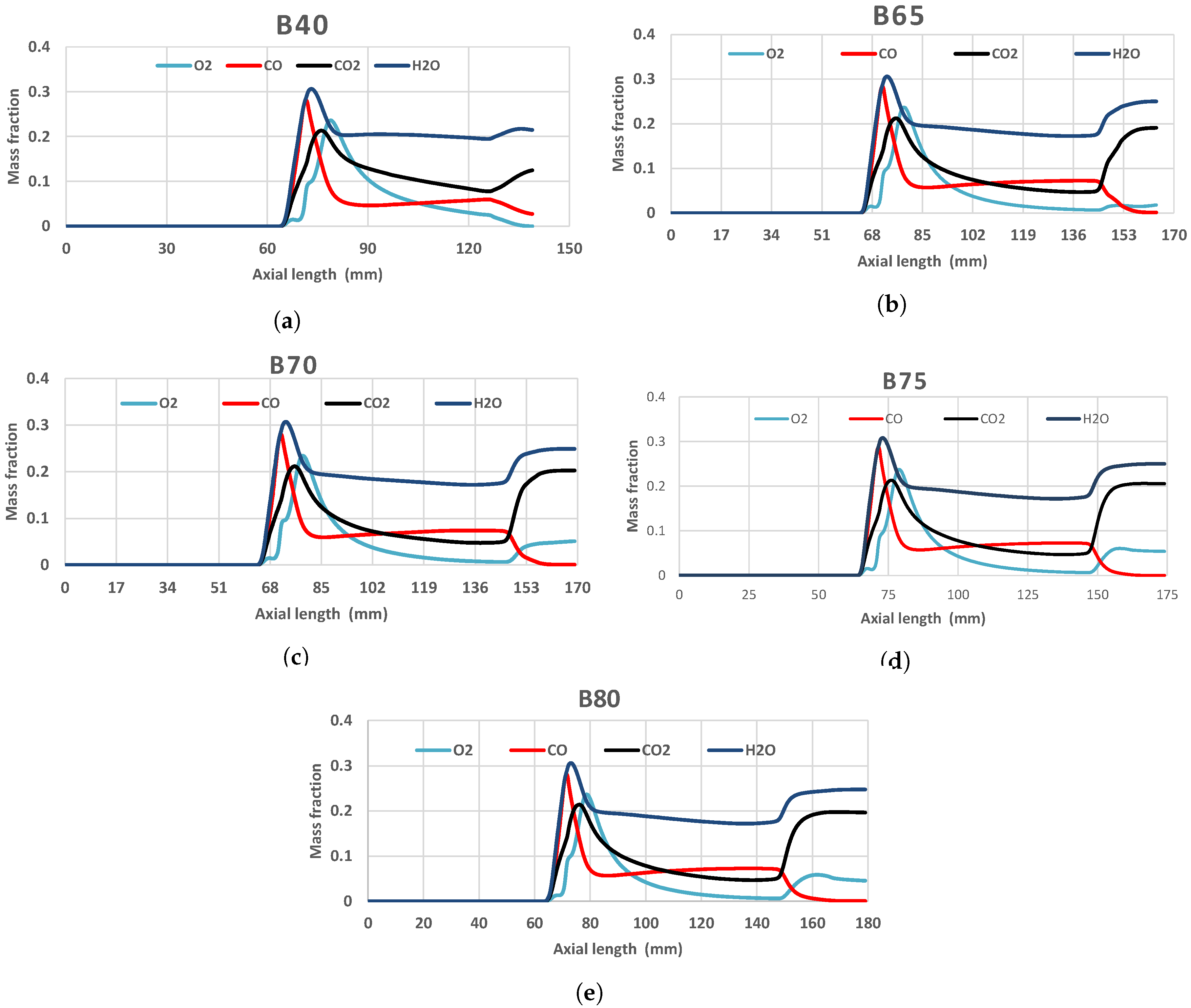
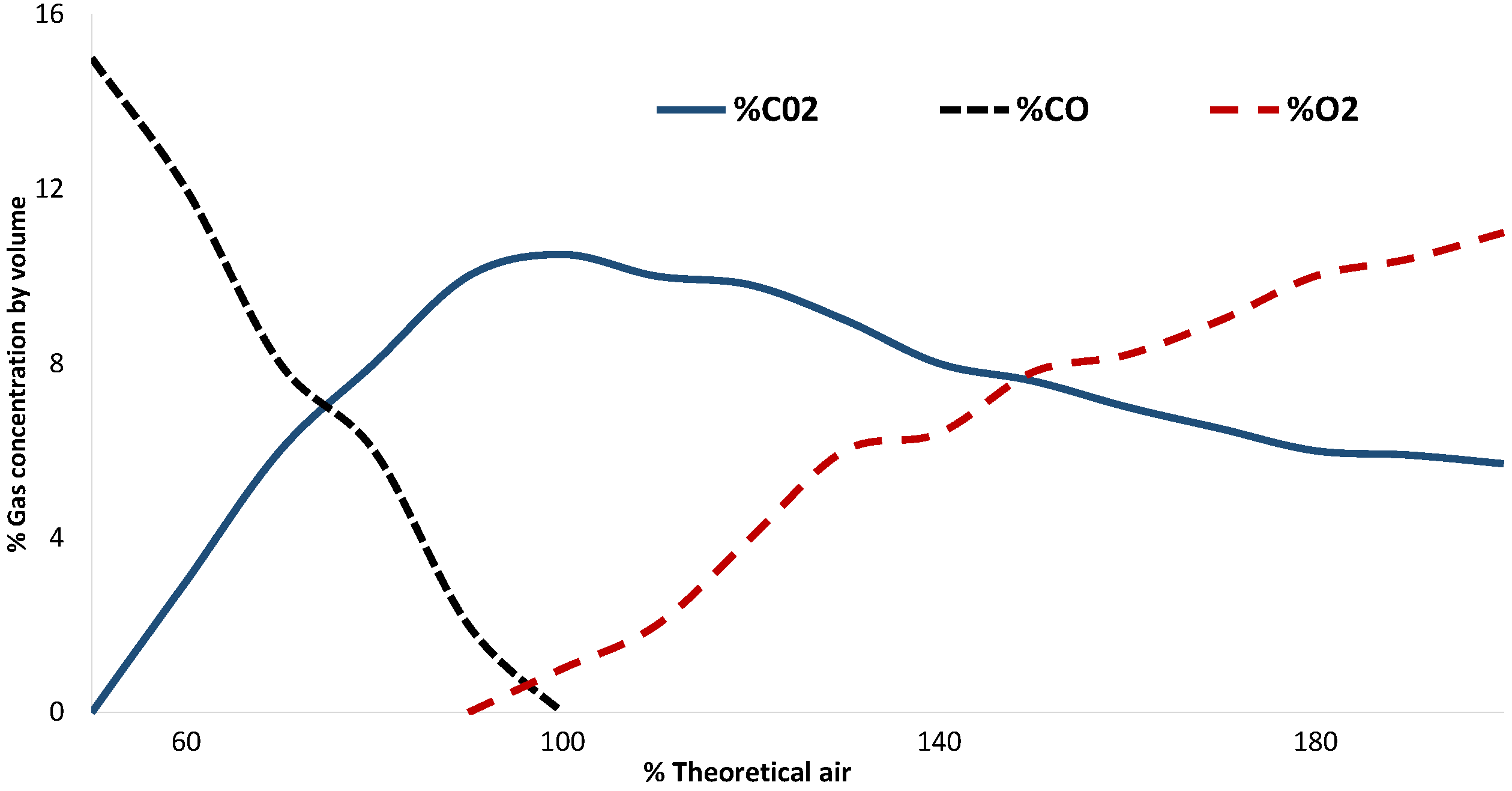
| Reaction | SKEL | Reaction | SKEL |
|---|---|---|---|
| 1 | 22 | ||
| 2 | 23 | ||
| 3 | 24 | ||
| 4 | 25 | ||
| 5 | 26 | ||
| 6 | 27 | ||
| 7 | 28 | ||
| 8 | 29 | ||
| 9 | 30 | ||
| 10 | 31 | ||
| 11 | 32 | ||
| 12 | 33 | ||
| 13 | 34 | ||
| 14 | 35 | ||
| 15 | 36 | ||
| 16 | 37 | ||
| 17 | 38 | ||
| 18 | 39 | ||
| 19 | 40 | ||
| 20 | 41 | ||
| 21 |
| Parameter | Values |
|---|---|
| Temperature at border 1 | 571.8 C |
| Temperature at border 2 | 574.3 C |
| Temperature at border 3 | 576.3 C |
| Temperature at border 4 | 587.8 C |
| Solver | Steady-state, turbulent realizable model |
| Operating condition | Atmospheric pressure of 10,132 Pa |
| Mass flow rate (inlet-air) | 7.2759 kg/s |
| Mass fraction (inlet-air) | 0.9 O |
| Mass flow rate (inlet-gas) | 8.4 kg/s |
| Mass fraction (inlet-gas) | 0.96 CH |
| Outlet | Gauge pressure of 0 Pa |
| mass fraction (outlet) | 0.9 O |
| Sides | Axisymmetric with x-axis |
| Under-relaxation factors | Pressure: 0.3; density: 0.4; body forces: 0.8; momentum: 0.7; species: 0.8; energy: 0.6 |
| Monitor | Mass-weighted average, mass fraction of CH |
| Monitor | Mass-weighted average, mass fraction of O |
| Residual error | 1 × 10 for continuity and 1 × 10 for velocity, , energy, and species |
| Initialization method | Hybrid initialization |
| Iterations | 7500 |
| Nodes | 250,668 nodes for 40 mm burner height; 295,429 nodes for 60 mm burner height; |
| 319,367 for 70 mm burner height; | |
| 329,305 for 75 mm burner height; 341,015 for 80 mm burner height; | |
| 363,114 for 90 mm burner height; 385,883 for 100 mm burner height. |
| Burner | CH | CO | O | CO | T |
|---|---|---|---|---|---|
| B-70 | 1.81 | 0.00073 | 0.05152 | 0.2027 | 285.95 |
| B-75 | 3.96 | 0.00041 | 0.05388 | 0.2054 | 267.48 |
| B-80 | 3.32 | 0.00036 | 0.04496 | 0.1963 | 263.3 |
| B-70 | B-80 | B-80 | B-80 | B-80 | |
| B-80 | B-70 | B-75 | B-75 | B-70 |
© 2020 by the authors. Licensee MDPI, Basel, Switzerland. This article is an open access article distributed under the terms and conditions of the Creative Commons Attribution (CC BY) license (http://creativecommons.org/licenses/by/4.0/).
Share and Cite
González-Durán, J.E.E.; Zamora-Antuñano, M.A.; Lira-Cortés, L.; Rodríguez-Reséndiz, J.; Olivares-Ramírez, J.M.; Lozano, N.E.M. Numerical Simulation for the Combustion Chamber of a Reference Calorimeter. Processes 2020, 8, 575. https://doi.org/10.3390/pr8050575
González-Durán JEE, Zamora-Antuñano MA, Lira-Cortés L, Rodríguez-Reséndiz J, Olivares-Ramírez JM, Lozano NEM. Numerical Simulation for the Combustion Chamber of a Reference Calorimeter. Processes. 2020; 8(5):575. https://doi.org/10.3390/pr8050575
Chicago/Turabian StyleGonzález-Durán, José Eli Eduardo, Marco Antonio Zamora-Antuñano, Leonel Lira-Cortés, Juvenal Rodríguez-Reséndiz, Juan Manuel Olivares-Ramírez, and Néstor Efrén Méndez Lozano. 2020. "Numerical Simulation for the Combustion Chamber of a Reference Calorimeter" Processes 8, no. 5: 575. https://doi.org/10.3390/pr8050575
APA StyleGonzález-Durán, J. E. E., Zamora-Antuñano, M. A., Lira-Cortés, L., Rodríguez-Reséndiz, J., Olivares-Ramírez, J. M., & Lozano, N. E. M. (2020). Numerical Simulation for the Combustion Chamber of a Reference Calorimeter. Processes, 8(5), 575. https://doi.org/10.3390/pr8050575







